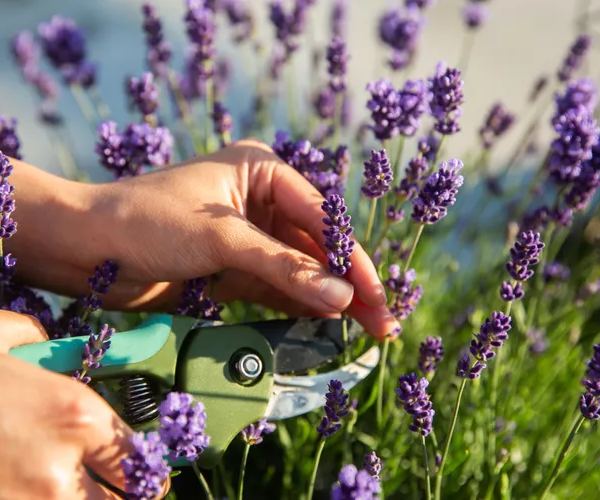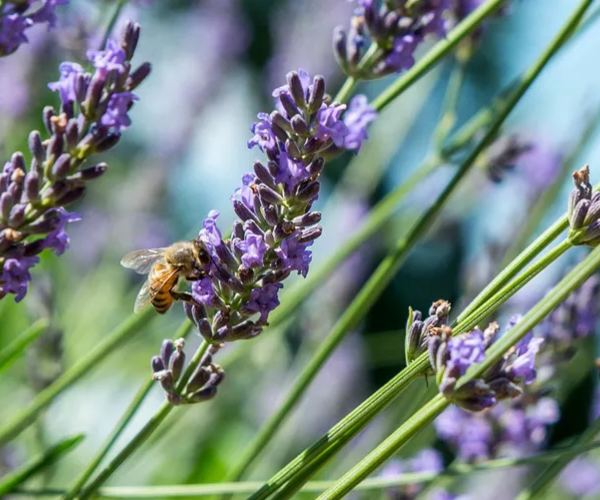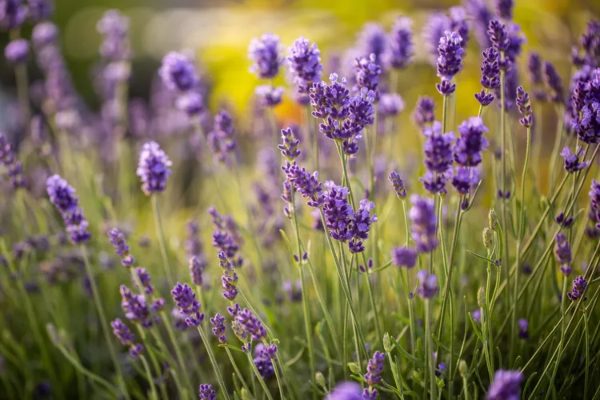English Lavender, also commonly known as lavender is often considered a herb. However, it is an herbaceous perennial with a semi-woody growth habit. It is normally grown for its dry leaves and flowers to make sachets and potpourri. It is also used for making oils used in sleep aromatherapy. This plant grows in mild conditions and thrives in full sun and well-draining soil.
While the oil of English lavender is much-loved, its oil may be toxic to people and pets.
Plant Attributes
- Common Name: English lavender, common lavender
- Botanical Name: Lavandula angustifolia
- Family: Lamiaceae
- Plant Type: Perennial, herbaceous
- Mature Size: 1-2 ft. tall, 2-3 ft. wide
- Sun Exposure: Full, partial
- Soil Type: Loamy, sandy, silt, well-drained
- Soil pH: Neutral, alkaline
- Bloom Time: Summer
- Flower Color: Purple, white, pink
- Hardiness Zones: 5-9 (USDA)
- Native Area: Mediterranean
- Toxicity: Toxic to people and pets
English Lavender care
English lavender gives a garden a good midsummer color and is often used in perennial borders and rock gardens. You can also find them in herb gardens and scent gardens. Here are some of the main care requirements for English lavender:
- Pick a sunny spot, normally that gets six hours or more of direct sunlight. That said, this plant can be grown in partial shade as well.
- Prepare well-draining soil that goes on the dryer side.
- During its growing stage, water English lavender occasionally. But once established, do not water regularly unless in periods of drought.
- Do not fertilize this plant.
Light
English lavender loves full sun. When grown in shady spots, these plants normally become leggy and produce lesser blooms. In some hot places, the plants do well due to some shade in the afternoon heat.

Soil
You have to plant English Lavender in a very sandy or gritty but well-draining soil. Humusy and damp soils are often the cause of root rot. A soil similar to its native Mediterranean region where the soil is dry and fertile would be the best. You do not have to add organic material to the soil as it can cause problems.
Also, Read How to Grow and Care for Sesame Plants!
Water
Baby lavender should be watered once every other day for the first week. Once established, they become drought tolerant and don’t like being watered that much, which could deter their ability to bloom. Mature plants should be watered only once a week or so based on the climate where you live. Increase the frequency to about every four days after flower buds form to promote a healthy harvest.
Temperature and Humidity
English lavenders grow best in conditions that are warm but not extremely hot. They like relatively dry climates and respond poorly to high humidity.
Fertilizer
Fertilizers usually are a big No-No with these plants. Fertilizing will also increase the risk of inability to bloom.
Types of English Lavender
- L. angustifolia ‘Hidcote‘: This is a very popular and fragrant shorter variety (about 20 inches tall) and has a mounded growth habit and dark purple flower spikes.
- Lavandula x intermedia ‘Hidcote Giant’: This is a larger version with long stems, achieving a height of 36 to 40 inches with very fragrant bright violet flower spikes.
- L. angustifolia ‘Munstead’: This variety is a slow-growing mounding variety 18 inches tall with rosy-purple flower spikes.
- L. angustifolia ‘Sarah’: This is a 12-inch-tall compact cultivar with medium purple flowers that are ideal for containers.
- L. angustifolia ‘Jean Davis’: This a small, slow-growing variety with light-pink flowers that grows to about 18 inches tall.
Pruning
Remove dead flower stalks to encourage continued bloom. For shaping, you can prune in spring after new stems and leaves have appeared. Also, light pruning in late summer or early fall before the first frost also increases good air circulation, which prevents rot. So, if you have the time, pruning twice a year is actually good for the plant’s health. This plant normally blooms only once a season but some varieties might give a second round of blooms after pruning.

Once the plants are established, in their second season and beyond that, it is good to prune the new spring growth after the plants leaf out. Just cut one-third of the green stalks. Do not cut into the old woody stems. Remember that shearing the plants to about eight inches from the ground in early spring every three years helps control the size of the plants, encouraging their new growth.
The pruned lavender can be used in making your own sachets and potpourri. You can just hang the bunches upside down by the stems to dry in a cool dark room with enough ventilation.
How to propagate English Lavender
Stem cuttings are the best way to propagate lavender than by growing from seeds. Learn these few steps to propagate lavender plants:
- Using a clean and sharp tool, cut six-inch-long shoots that do not have a flower or bud. Remove the lower leaves.
- Dip the cut ends into rooting hormone but this step is optional.
- Plant the cuttings in a pot filled with potting soil or sand.
- Locate the cuttings in a part-shade area and water regularly until they develop roots. Roots should develop in about three weeks for planting outdoors or in an indoor container.
Potting and Repotting lavender
You can grow English lavender in pots as long as the soil is well-draining and the plant gets enough sunlight. If you see roots coming out of the bottom hole, you know it is time to repot the plant.
When repotting, choose a pot that is one size up and has a drainage hole. We recommend choosing a terra-cotta pot that will evaporate excess moisture from the soil. Keep the root ball together and move the plant into its new pot with fresh soil that drains the water quickly.
Overwintering
If the soil is too wet or if the temperature falls below zero degrees, English lavender might not survive without any protection or mulch. At the cooler northern edge of its hardiness range, these plants should be given a thick layer of mulch until spring for their survival. To fight problems with high humidity levels, you can mulch them with gravel or rock rather than organic ones.

Common plant diseases
Luckily, English lavender is not affected by many diseases. That being said, it is still prone to leaf spot and root rot. Get rid of affected leaves to prevent leaf spots. Plants that have leaf spots may require better air circulation. Do not overwater as it is the main cause of root rot. They do not prefer constantly moist soil.
How to get English Lavender to bloom
If you plant English lavender in the correct spot with enough sunlight and good soil, this plant will give you blooms year after year.
Bloom months
This plant normally blooms in late May or June, depending on the place. It blooms for about a month.
What does English lavender look and smell like?
The lavender flowers are usually small, densely packed, and pinecones-shaped. Just like their name, lavenders are typically a purple shade. The flowers and the leaves give the signature fragrance, a combination of woodsy and sweet.
How to encourage more blooms
First of all, ensure that your English lavender is getting enough light. While it can survive in partial shade as well, a location with full sunlight is much better. Also, do not fertilize this plant as it can deter flowering. Lastly, do not overwater. If you feel that consistent moisture is the issue, transplant the plant to a spot that provides it with better-draining soil.
Caring for English Lavender when it blooms
Once the blooms are over, cut back the flowers. If the summers are not that hot, you may experience a second round of blooms. Until then, wait until early next spring to prune.
Deadheading English lavender flowers
If you want to encourage more blooms, deadheading spent flowers is a great option. We all know English lavender for its blooms. You can make a sachet or potpourri with your harvest.
FAQs
Q: Is English lavender easy to care for?
A: It’s very easy to maintain if the plant is growing in the right conditions: medium to dry, infertile soil in full sun. It dislikes fertile soil, humidity, soggy soil, and overly hot conditions.
Q: How fast does English lavender grow?
A: It has a moderately slow growth rate. Prune new growth in the spring to maintain a rounded shape; do not prune its woody stems.
Q: What is the difference between English and French lavender?
A: The French variety of lavender (Lavandula stoechas) prefers a warmer climate and is not as cold-hardy as its English cousin. It is also somewhat more sensitive and less durable than English lavender. Because nursery labeling is sometimes inaccurate, make sure you are buying true English lavender (Lavandula angustifolia), especially if you live in the colder zones of its hardiness range.
Q: Can English lavender grow indoors?
A: English lavender is typically grown outdoors, but it can thrive when potted indoors if the plant is given a minimum of four to six hours of bright, direct sunlight each day. It also prefers low-humidity environments with consistent, moderate temperatures.
Also, Read A Complete Guide to Grow and Care for Hens and Chicks Plants
